An Integrated Data Acquisition Approach for the Structural Health Monitoring and Real-Time Earthquake Response Assessment of a Retrofitted Adobe Church in Peru
Abstract
:1. Introduction
- Initial assessment (May 2015): The work began with in situ inspections and non-destructive testing, including ambient vibration testing (AVT) and sonic testing. This was followed by numerical modeling and structural analysis to replicate the existing damage and evaluate the current safety through nonlinear static and dynamic analyses [2,10].
- Retrofitting scheme development (2016): A retrofitting scheme using traditional and locally available materials and techniques was developed, considering the presence of wall paintings on the interior surfaces. The University of Minho (UMinho) numerically validated the retrofitting design and provided optimization suggestions, incorporated in the final design. The strengthening scheme primarily involved internal and external bracing with timber elements, such as bond beams, tie beams, anchors, and corner keys, as well as the addition of buttresses (presented in detail in [2,11,12]). It also included the consolidation and partial replacement of damaged exterior adobe and base course masonry parts.
- Retrofitting completion (June 2019): The retrofitting works were completed by the Cusco Directorate of the Ministry of Culture of Peru, culminating in the church’s inauguration and official reopening.
- Post-retrofit assessment (December 2019, 2022): UMinho conducted a second in situ inspection and experimental round of AVT and sonic testing in December 2019. In May 2022, additional damage mapping of the retrofitted church was conducted based on the definition of main structural damage in earthen buildings, presented in Ahmadi et al. [13], which documented the formation of cracking, indicative of active destabilizing actions, possibly settlement.
- Long-term monitoring (May 2022): The installation of a permanent long-term SHM system by UMinho records structural, environmental, and earthquake parameters.
2. Equipment and Methods
- (a)
- One exterior air temperature and relative humidity sensor. The sensor is located at the top east end of the south lateral wall. It is protected by solar radiation and precipitation shield. The sampling rate for both sensors is set to 20 Hz (20 samples/s). The measurement range is 0–100% RH and −40–+80 °C, with a protection of IP65 and a measurement accuracy of ±1.5% RH (0–90% RH) and ±0.2 ° (0–+40 °C). Model: HUMICAP Probe HMP110. Manufacturer: Vaisala (Vantaa, Finland).
- (b)
- Five accelerometers at the top eaves of the nave and presbytery walls. The sensors are piezoelectric uniaxial accelerometers with a frequency range of 0.15 to 1000 Hz, a measurement range of ±0.5 g, and a high sensitivity of 10,000 mV/g. The signals are recorded with a sampling frequency equal to 200 Hz (200 samples/s). The sensors are mounted with small anchors on the interior surfaces: two at the top eave of the north nave and presbytery wall, two in the south nave and presbytery wall, and one at the top of the gable end of the east façade. Model: 393B12. Manufacturer: PCB Piezotronics (Depew, NY, USA).
- (c)
- One linear potentiometer crack-meter, anchored to the adobe wall of the staircase leading to the choir loft, crossing a large vertical crack, which was present before the retrofitting works. The sensor has a measuring range of ±25 mm, an accuracy of ±0.0625 mm, and a protection of IP67. It is installed with a PT100 temperature sensor (Manufacturer: Rs-components, London, UK) on the side, embedded in the adobe wall. The sampling rate is set to 20 Hz (20 samples/s). Model: J6-1-25. Manufacturer: Soil Instruments (Uckfield, UK).
- (d)
- Two MEMS tilt-meter sensors are placed on the north nave wall and gable end of the baptistery to monitor vertical rotations. Their angle-measuring range is ±5° and their accuracy is ±0.05%. They are installed with a PT100 temperature sensor (Manufacturer: Rs-components, London, UK), one on each side, embedded in the adobe wall. The sampling rate is set to 20 Hz (20 samples/s). Model: TLT6-U-5 MEMS. Manufacturer: Soil Instruments (Uckfield, UK).
- (e)
- One triaxial accelerometer, mounted on the interior surface, at the base of the east side wall of the baptistery to record strong motions from seismic events. It has a high resolution (0.0008 m/s²), a sensitivity of 100 mV/g, a measurement range of ±50 g pk, and a frequency range of 0.5 to 5000 Hz (±5%). The signals are recorded with a sampling frequency equal to 200 Hz (200 samples/s). Model: 356A16. Manufacturer: PCB Piezotronics (Depew, NY, USA).
- (f)
- One data acquisition system of two versatile 24-bit USB data acquisition boards with sixteen channels (eight IEPE channels and eight voltage channels). Acquisition recordings are simultaneous for all sensors, considering different specifications and sampling rates. Both acquisition boards are connected to a laptop, two uninterruptible power supply (UPS) units, offering about 1 h of power autonomy during an electricity cutoff, and a Wi-Fi router. Model: SIRIUS. Manufacturer: Dewesoft (Trbovlje, Slovenia).
3. Results
3.1. Ground Motion Recording
3.2. Environmental Parameters
3.3. Crack Opening
3.4. Out-of-Plane Rotations
3.5. Modal Properties
3.5.1. Ambient Vibration Testing before SHM and Mode Selection
3.5.2. SHM of Dynamic Properties
4. Discussion
Author Contributions
Funding
Institutional Review Board Statement
Informed Consent Statement
Data Availability Statement
Acknowledgments
Conflicts of Interest
References
- Cancino, C.; Lardinois, S. Seismic Retrofitting Project: Assessment of Prototype Buildings; 2 vols; Getty Conservation Institute: Los Angeles, CA, USA, 2012; Available online: https://www.getty.edu/conservation/publications_resources/pdf_publications/assess_prototype.html (accessed on 13 August 2024).
- Lourenço, P.B.; Greco, F.; Barontini, A.; Ciocci, M.P.; Karanikoloudis, G. Seismic Retrofitting Project: Modeling of Prototype Buildings; Getty Conservation Institute: Los Angeles, CA, USA; TecMinho—University of Minho: Guimarães, Portugal, 2019; Available online: https://www.getty.edu/conservation/publications_resources/pdf_publications/modeling-prototype-buildings.html (accessed on 13 August 2024).
- Saisi, A.; Gentile, C.; Guidobaldi, M. Post-earthquake continuous dynamic monitoring of the Gabbia Tower in Mantua, Italy. Constr. Build. Mater. 2015, 81, 101–112. [Google Scholar] [CrossRef]
- Cavalagli, N.; Comanducci, G.; Ubertini, F. Earthquake-Induced Damage Detection in a Monumental Masonry Bell-Tower Using Long-Term Dynamic Monitoring Data. J. Earthq. Eng. 2018, 22 (Suppl. S1), 96–119. [Google Scholar] [CrossRef]
- Kita, A.; Cavalagli, N.; Ubertini, F. Temperature effects on static and dynamic behavior of Consoli Palace in Gubbio, Italy. Mech. Syst. Signal Process. 2019, 120, 180–202. [Google Scholar] [CrossRef]
- Venanzi, I.; Kita, A.; Cavalagli, N.; Ierimonti, L.; Ubertini, F. Continuous OMA for damage detection and localization in the Sciri Tower in Perugia, Italy. In Proceedings of the 8th IOMAC—International Operational Modal Analysis Conference, Copenhagen, Denmark, 13–15 May 2019; pp. 127–136. [Google Scholar]
- Gentile, C.; Guidobaldi, M.; Saisi, A. One-year dynamic monitoring of a historic tower: Damage detection under changing environment. Meccanica 2016, 51, 2873–2889. [Google Scholar] [CrossRef]
- Sivori, D.; Ierimonti, L.; Venanzi, I.; Ubertini, F.; Cattari, S. An Equivalent Frame Digital Twin for the Seismic Monitoring of Historic Structures: A Case Study on the Consoli Palace in Gubbio, Italy. Buildings 2023, 13, 1840. [Google Scholar] [CrossRef]
- Borlenghi, P.; Gentile, C.; D’Angelo, M.; Ballio, F. Long-term monitoring of a masonry arch bridge to evaluate scour effects. Constr. Build. Mater. 2024, 411, 134580. [Google Scholar] [CrossRef]
- Karanikoloudis, G.; Lourenço, P.B. Structural assessment and seismic vulnerability of earthen historic structures. Application of sophisticated numerical and simple analytical models. Eng. Struct. 2018, 160, 488–509. [Google Scholar] [CrossRef]
- Case Study: Kuñotambo. Seismic Retrofitting Project. 2017. Available online: www.getty.edu/conservation/our_projects/field_projects/seismic/case_study_kunotambo.html (accessed on 13 August 2024).
- Ahmadi, S.S.; Karanikoloudis, G.; Mendes, N.; Illambas, R.; Lourenço, P.B. Appraising the Seismic Response of a Retrofitted Adobe Historic Structure, the Role of Modal Updating and Advanced Computations. Buildings 2022, 12, 1795. [Google Scholar] [CrossRef]
- Ioannou, I.; Illampas, R. Long-Term Performance and Durability of Masonry Structures. Chapter 4: Earth Masonry; Ghiassi, B., Lourenço, P.B., Eds.; Woodhead Publishing: Cambridge, UK, 2019; pp. 89–127. [Google Scholar] [CrossRef]
- ICOMOS. Recommendations for the Analysis, Conservation and Structural Restoration of Architectural Heritage—Guidelines; International Council of Monuments and Sites: Charenton-le-Pont, France, 2003. [Google Scholar]
- Cardani, G.; Massetti, G.E. When the strengthening of historic masonry buildings should be carried out in different phases: The structural reinforcement and monitoring of the Lombard-Romanesque church of Saint Bassiano, in Pizzighettone (CR), Italy. In Proceedings of the 3rd International Conference on Protection of Historical Constructions, Lisbon, Portugal, 12–15 July 2017. [Google Scholar]
- Karanikoloudis, G.; Lourenço, P.B.; Mendes, N.; Serra, J.B.; Boroschek, R. Monitoring of Induced Groundborne Vibrations in Cultural Heritage Buildings: Miscellaneous Errors and Aliasing through Integration and Filtering. Int. J. Archit. Herit. 2021, 15, 205–228. [Google Scholar] [CrossRef]
- Cattari, S.; Ottonelli, D.; Mohammadi, S. EQ-DIRECTION Procedure towards an Improved Urban Seismic Resilience: Application to the Pilot Case Study of Sanremo Municipality. Sustainability 2024, 16, 2501. [Google Scholar] [CrossRef]
- Makoond, N.; Pelà, L.; Molins, C.; Roca, P.; Alarcón, D. Automated data analysis for static structural health monitoring of masonry heritage structures. Struct. Control Health Monit. 2020, 27, e2581. [Google Scholar] [CrossRef]
- Allen, V. Automatic earthquake recognition and timing from single traces. Bull. Seismol. Soc. Am. 1978, 68, 1521–1532. [Google Scholar] [CrossRef]
- Saari, J. Automated Phase Picker and source location algorithm for local distances using a single three-component seismic station. Tectonophysics 1991, 189, 307–315. [Google Scholar] [CrossRef]
- Krylov, A.A.; Lobkovsky, L.I.; Ivashchenko, A.I. Automated detection of mi-croearthquakes in continuous noisy records produced by local ocean bottom seismographs or coastal networks. Russ. J. Earth. Sci. 2019, 19, ES2001. [Google Scholar] [CrossRef]
- Earthquake Hazards Program|U.S. Geological Survey. 2024. Available online: https://earthquake.usgs.gov/ (accessed on 13 August 2024).
- Huerta, A.; Lavado-Casimiro, W. Trends and variability of precipitation extremes in the Peruvian Altiplano (1971–2013). Int. J. Climatol. 2021, 41, 513–528. [Google Scholar] [CrossRef]
- Zonno, G.; Aguilar, R.; Boroschek, R.; Lourenço, P.B. Experimental analysis of the thermohygrometric effects on the dynamic behavior of adobe systems. Constr. Build. Mater. 2019, 208, 158–174. [Google Scholar] [CrossRef]
- SVS. ARTeMIS Modal Pro User Manual, Release 6.0.2.0; Structural Vibration Solutions: Aalborg, Denmark, 2019. [Google Scholar]
- Brincker, R.; Zhang, L.; Andersen, P. Modal identification of output-only systems using frequency domain decomposition. Smart Mater. Struct. 2001, 10, 441–445. [Google Scholar] [CrossRef]
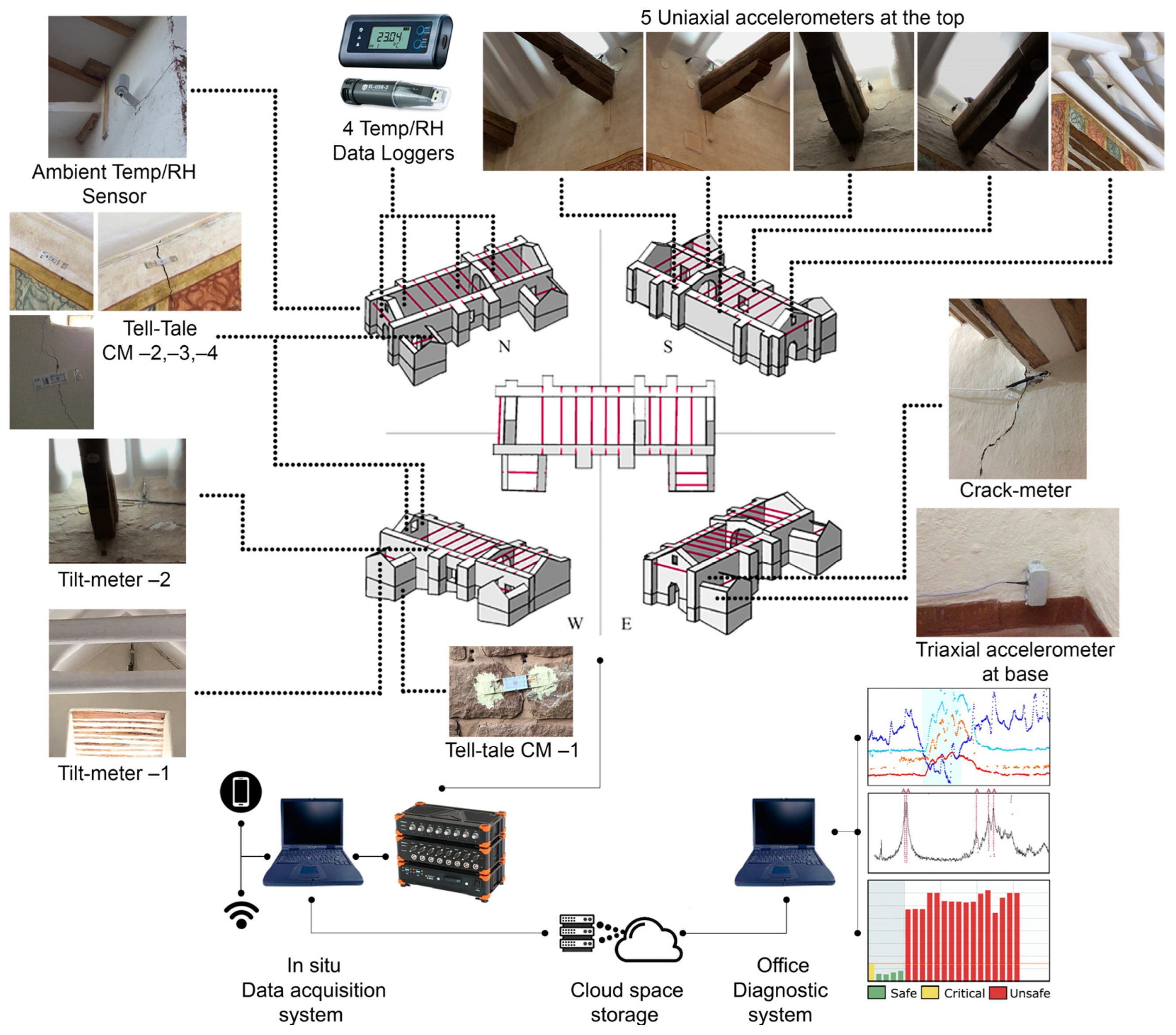
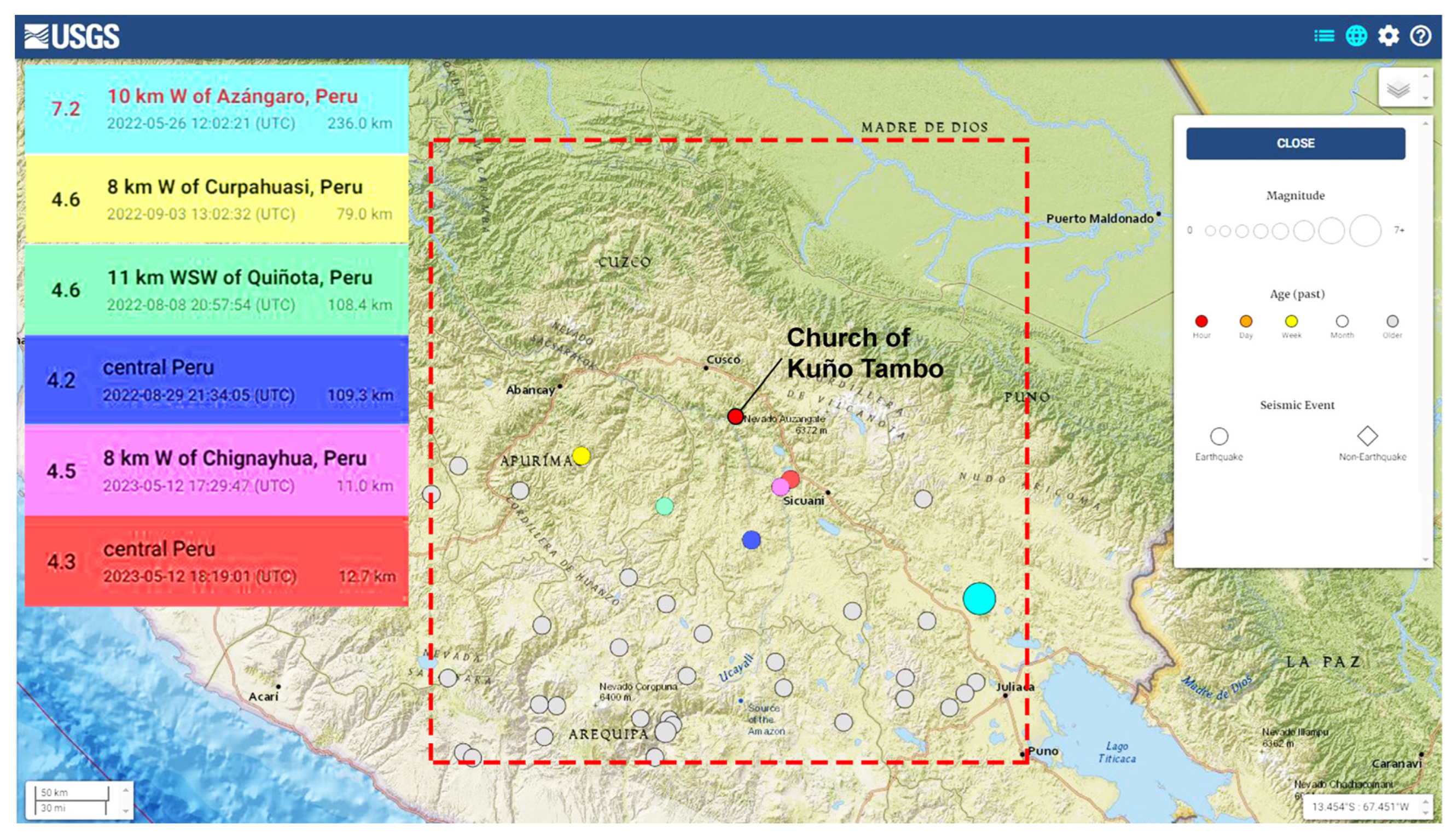
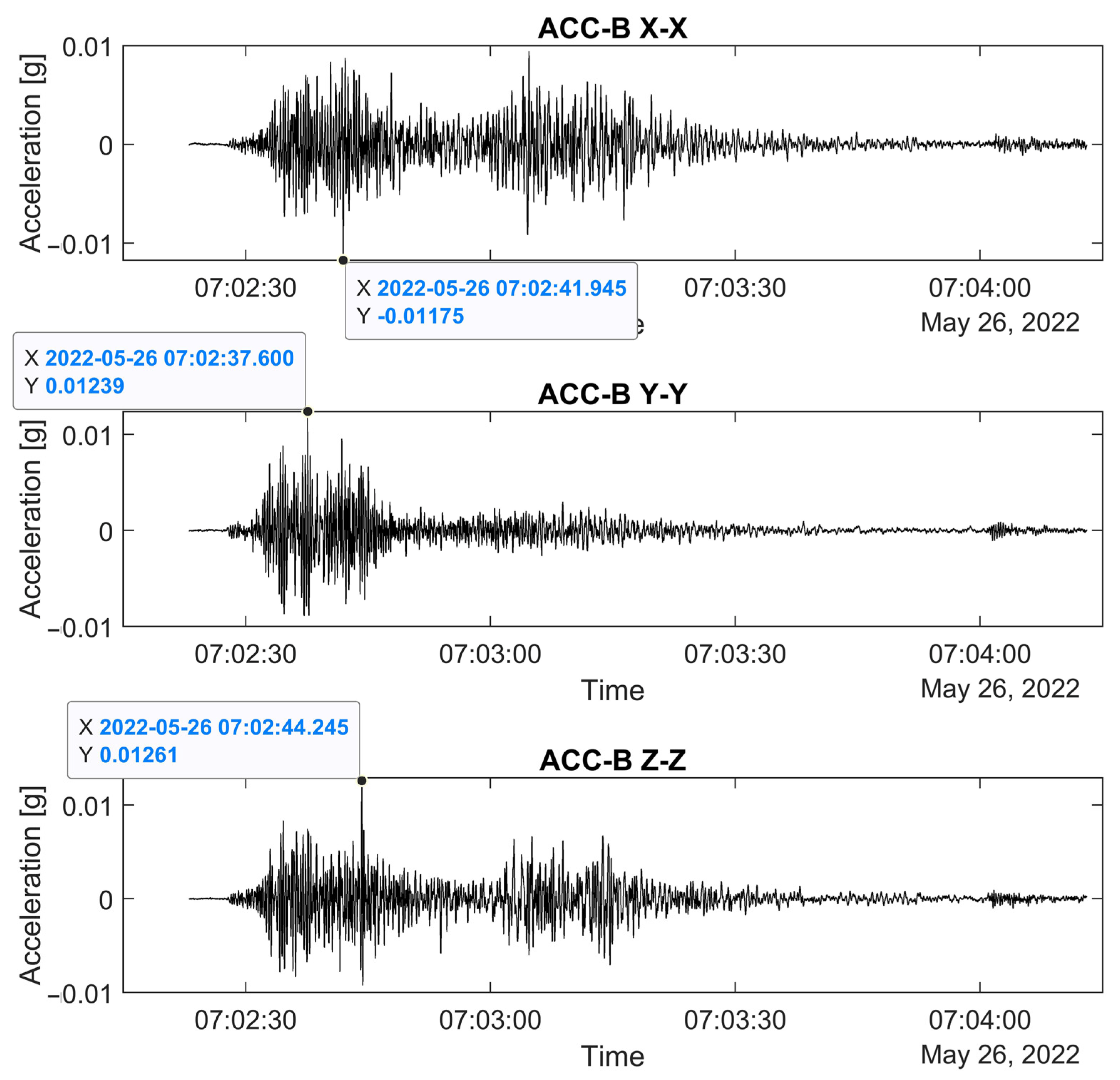
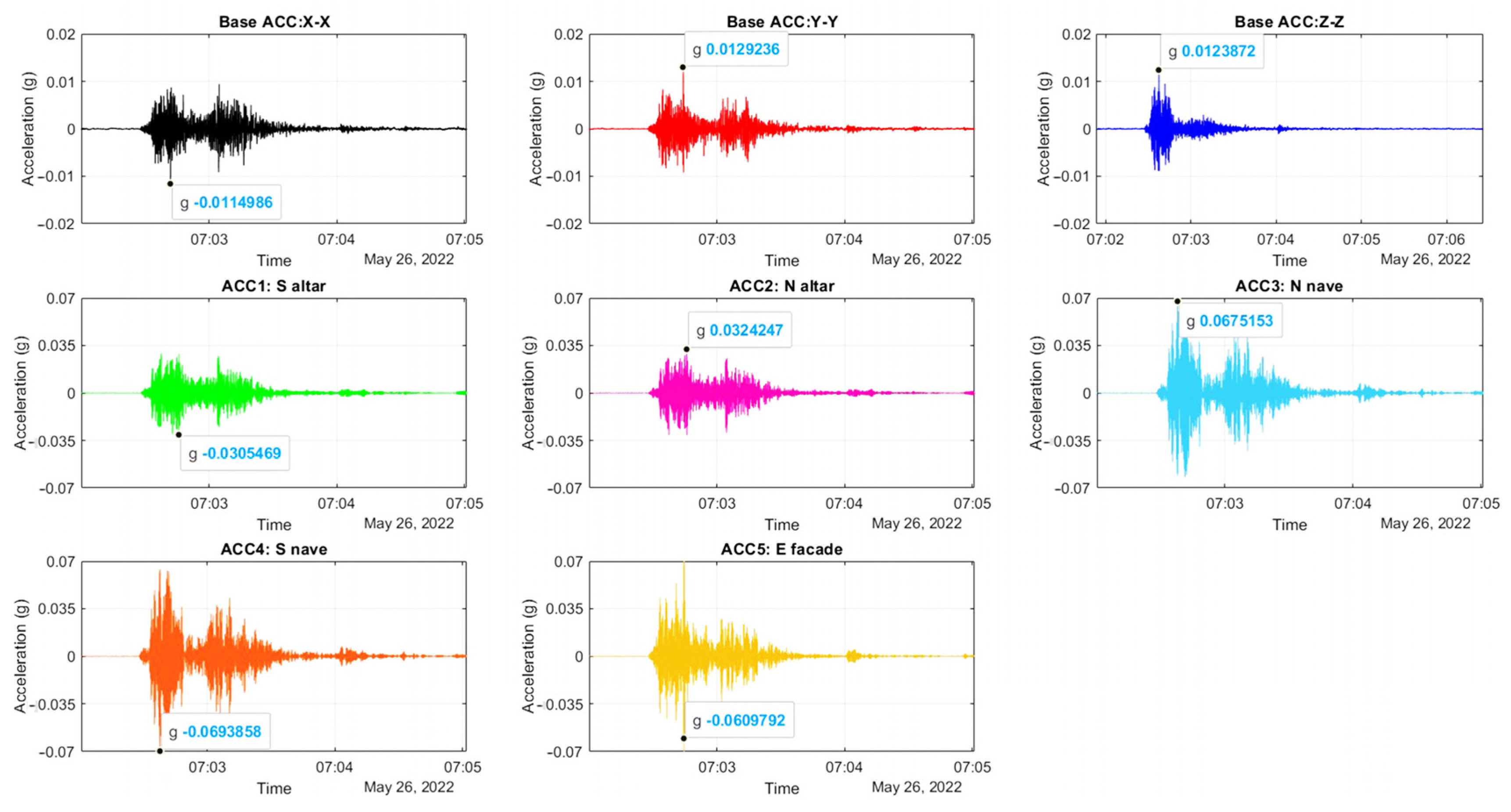



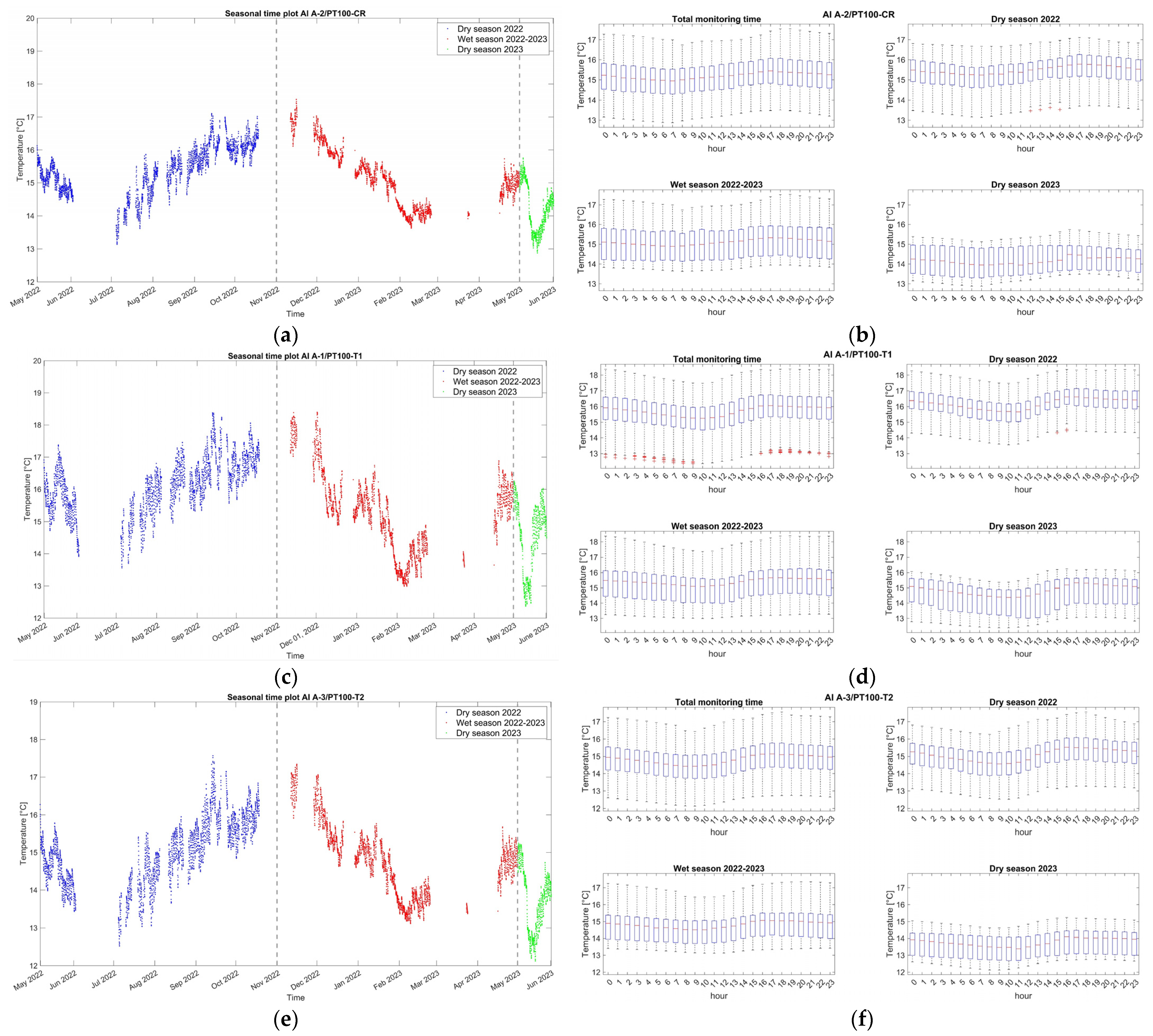


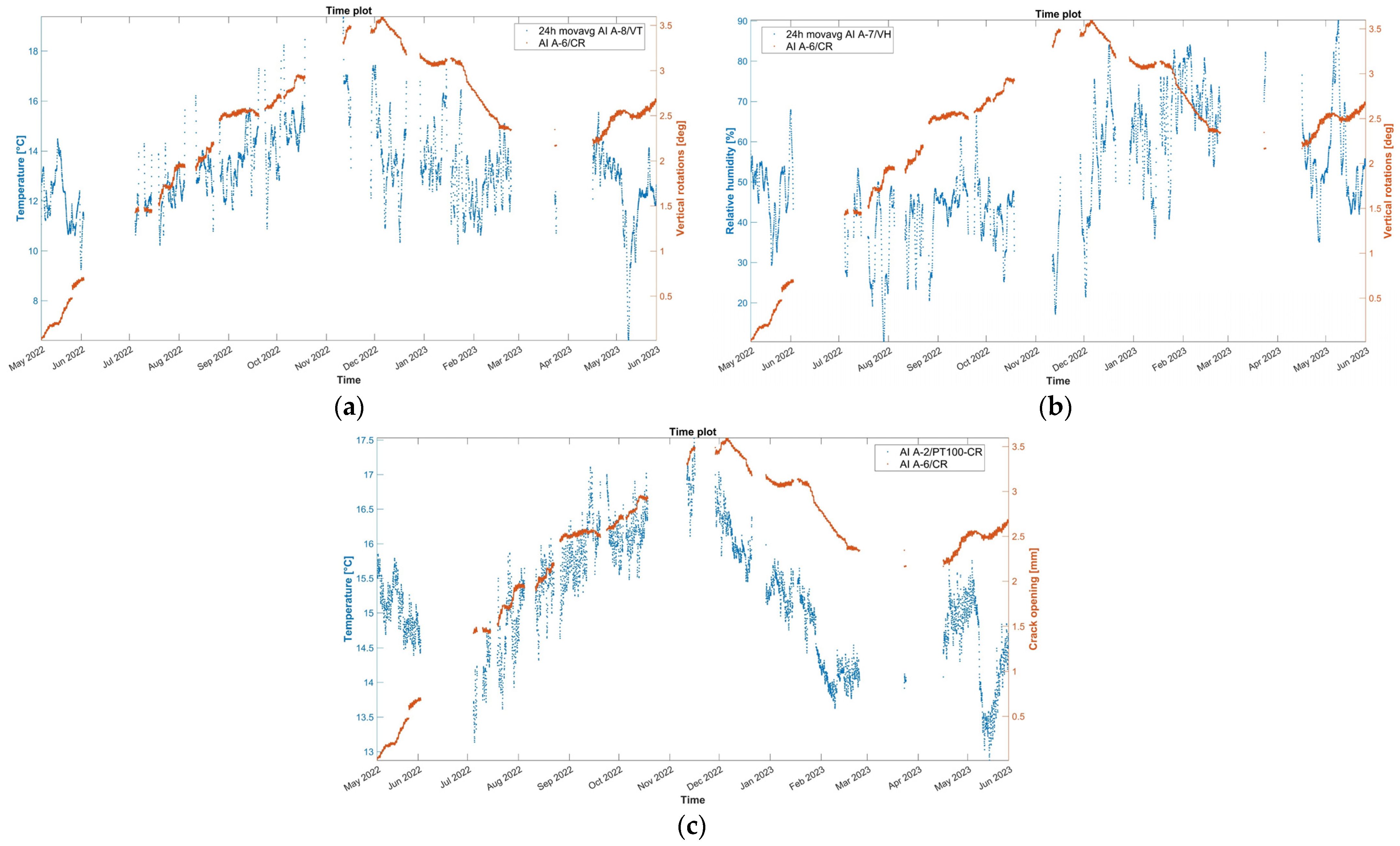

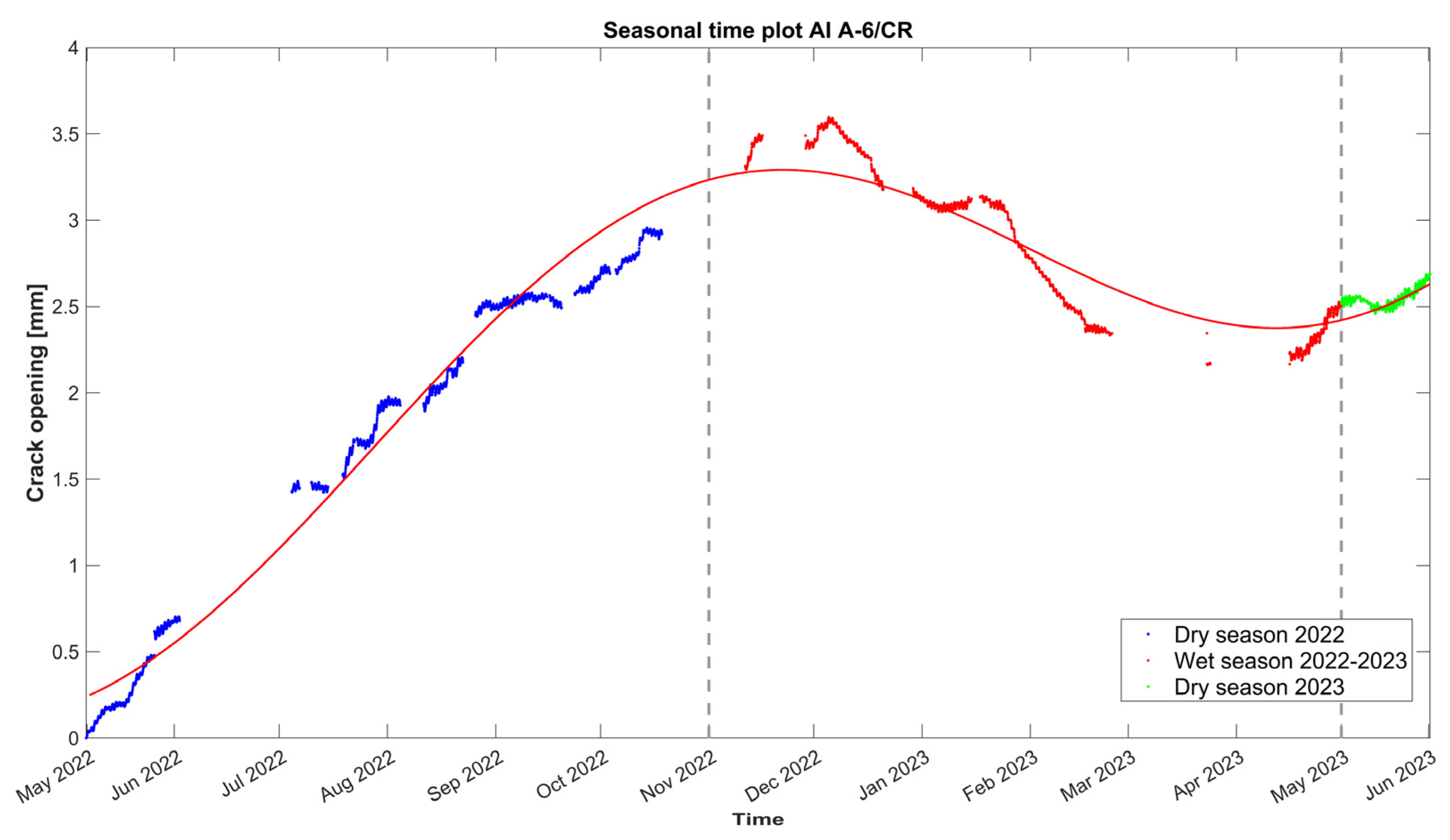
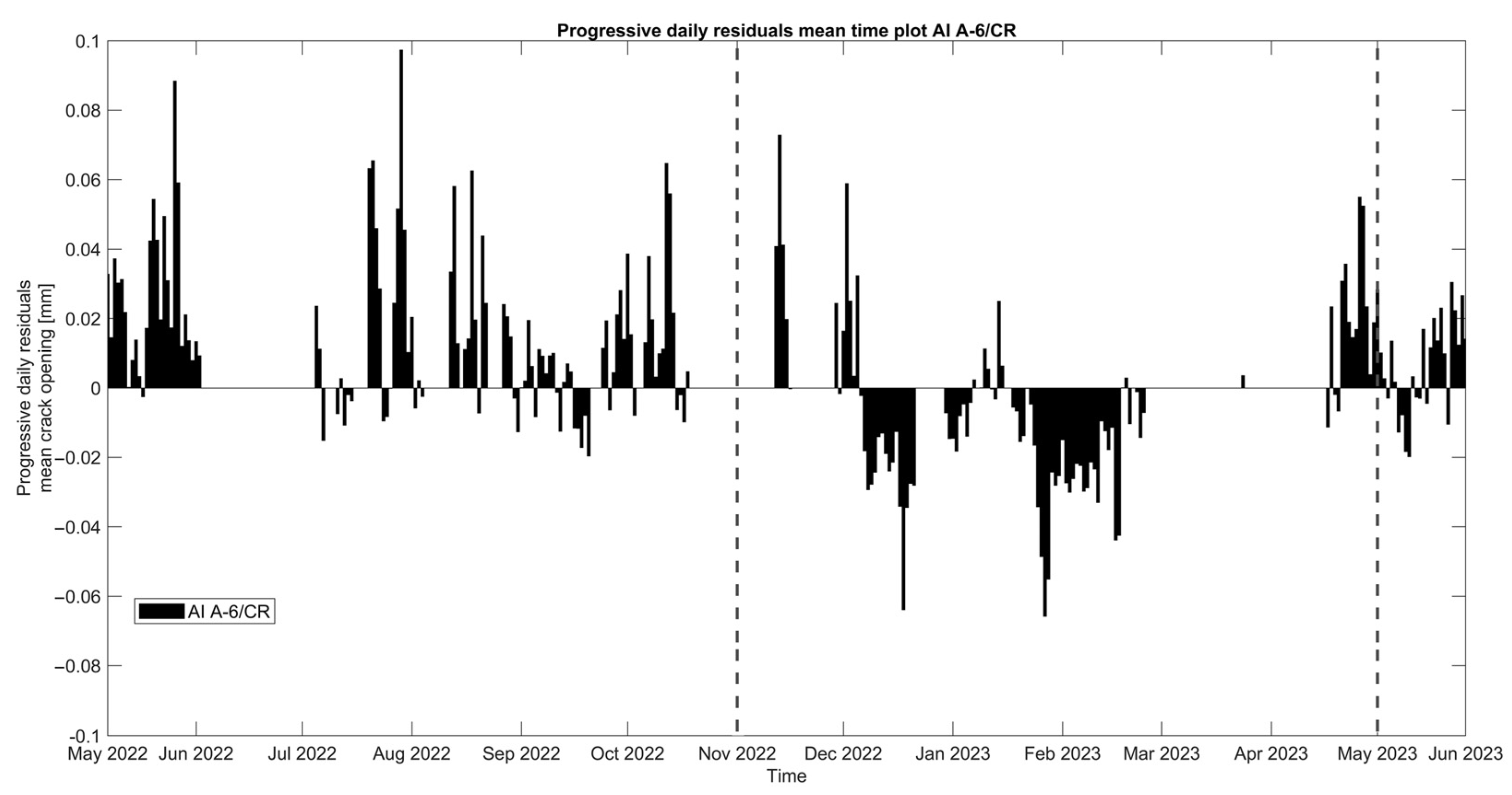
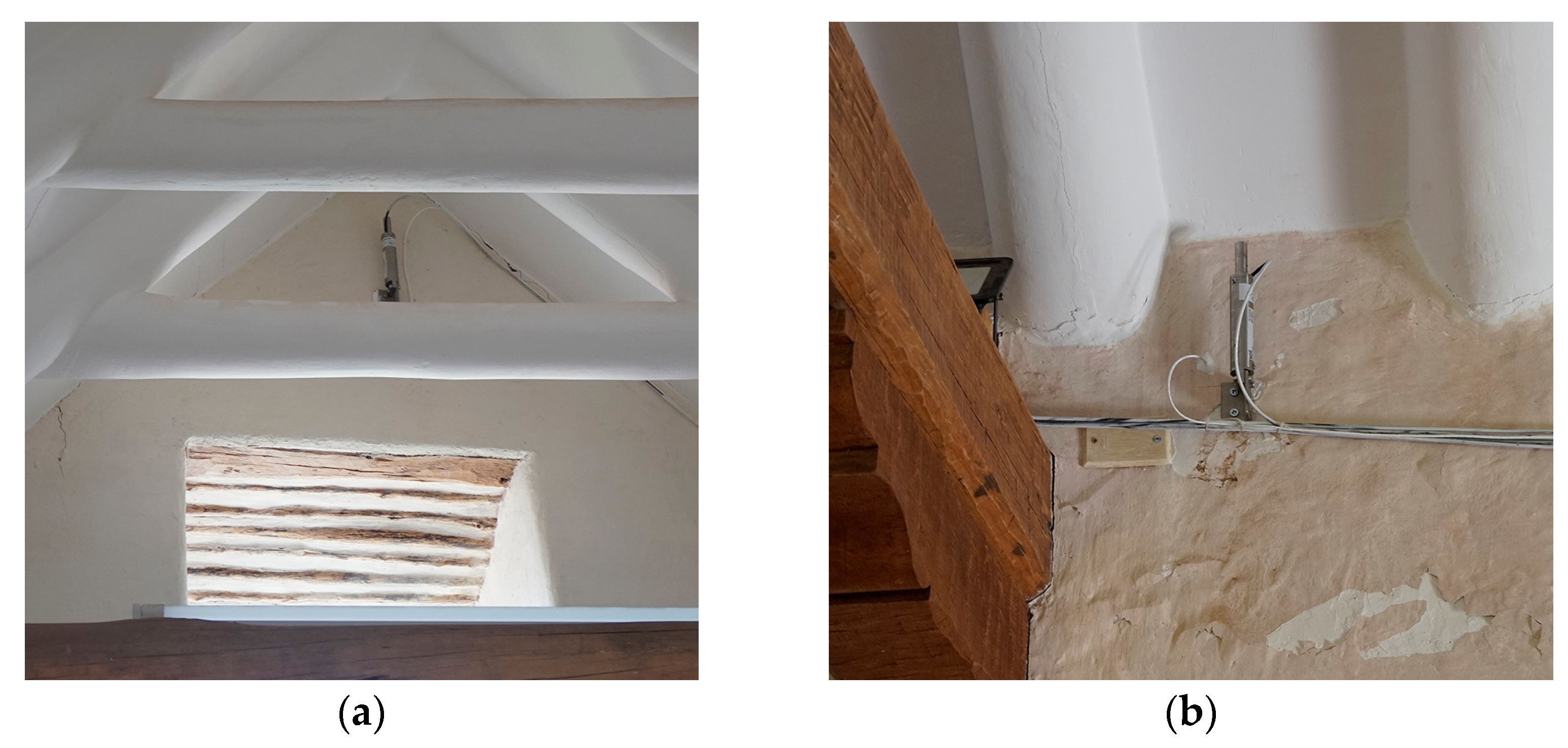

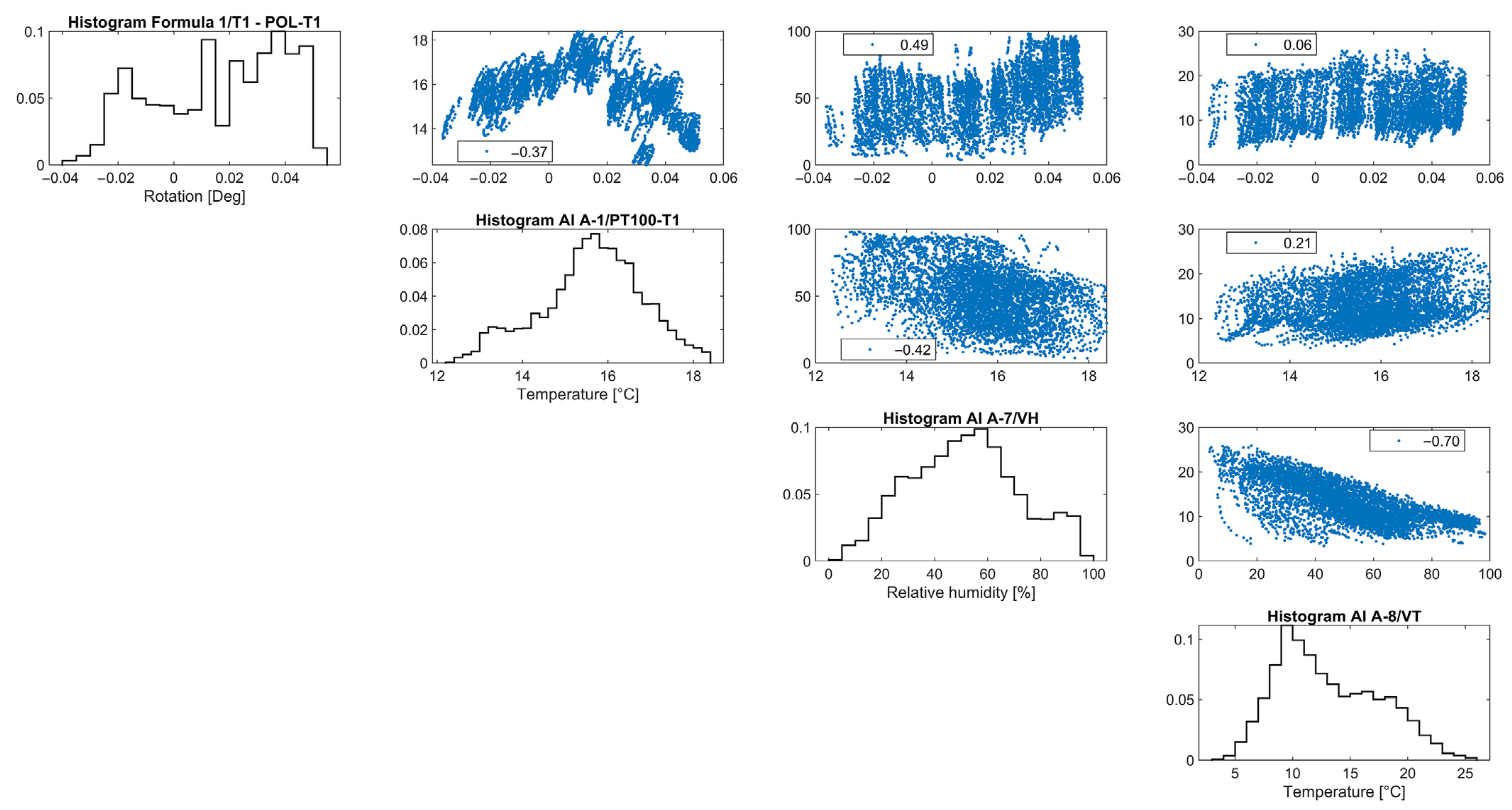
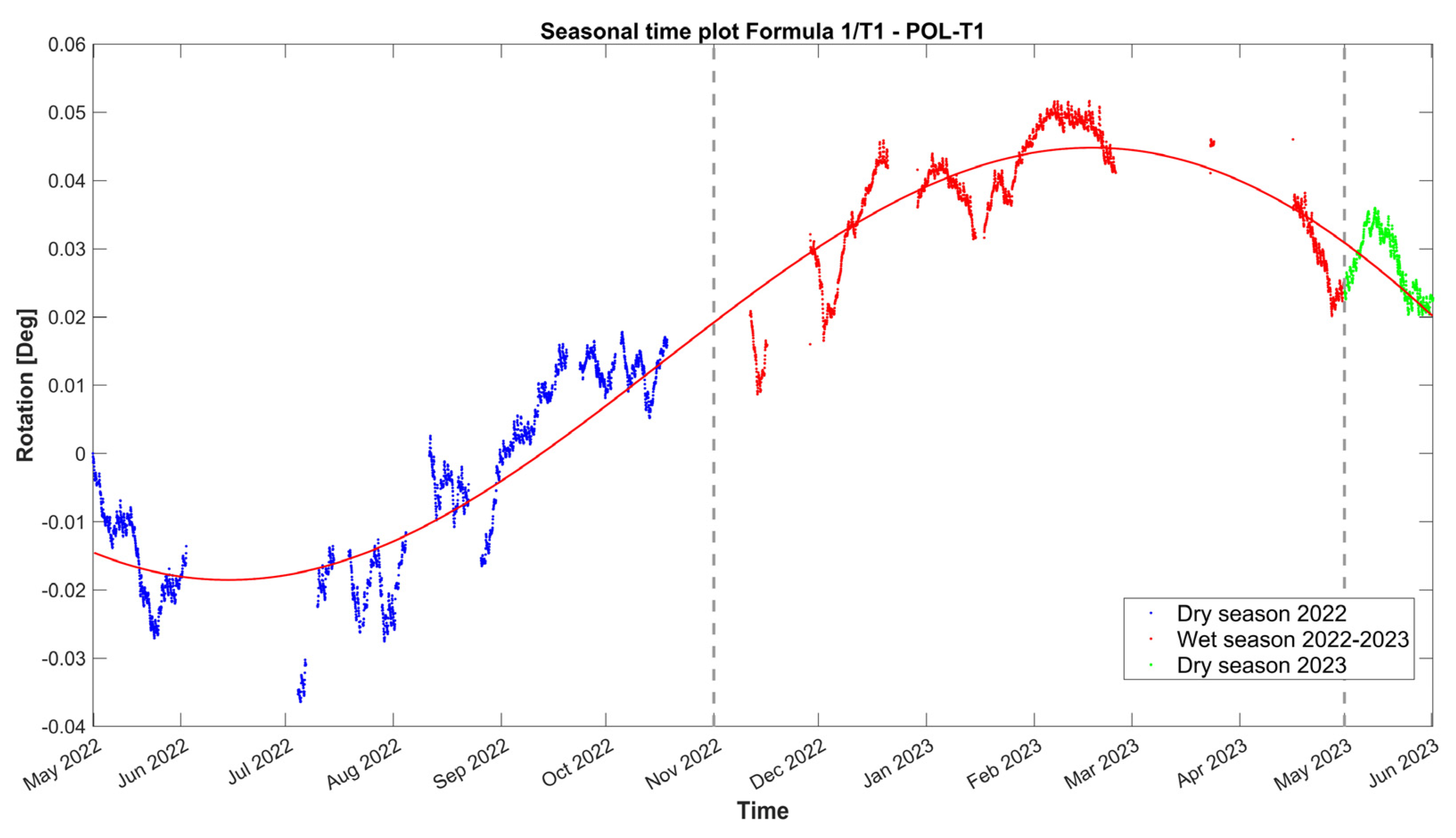

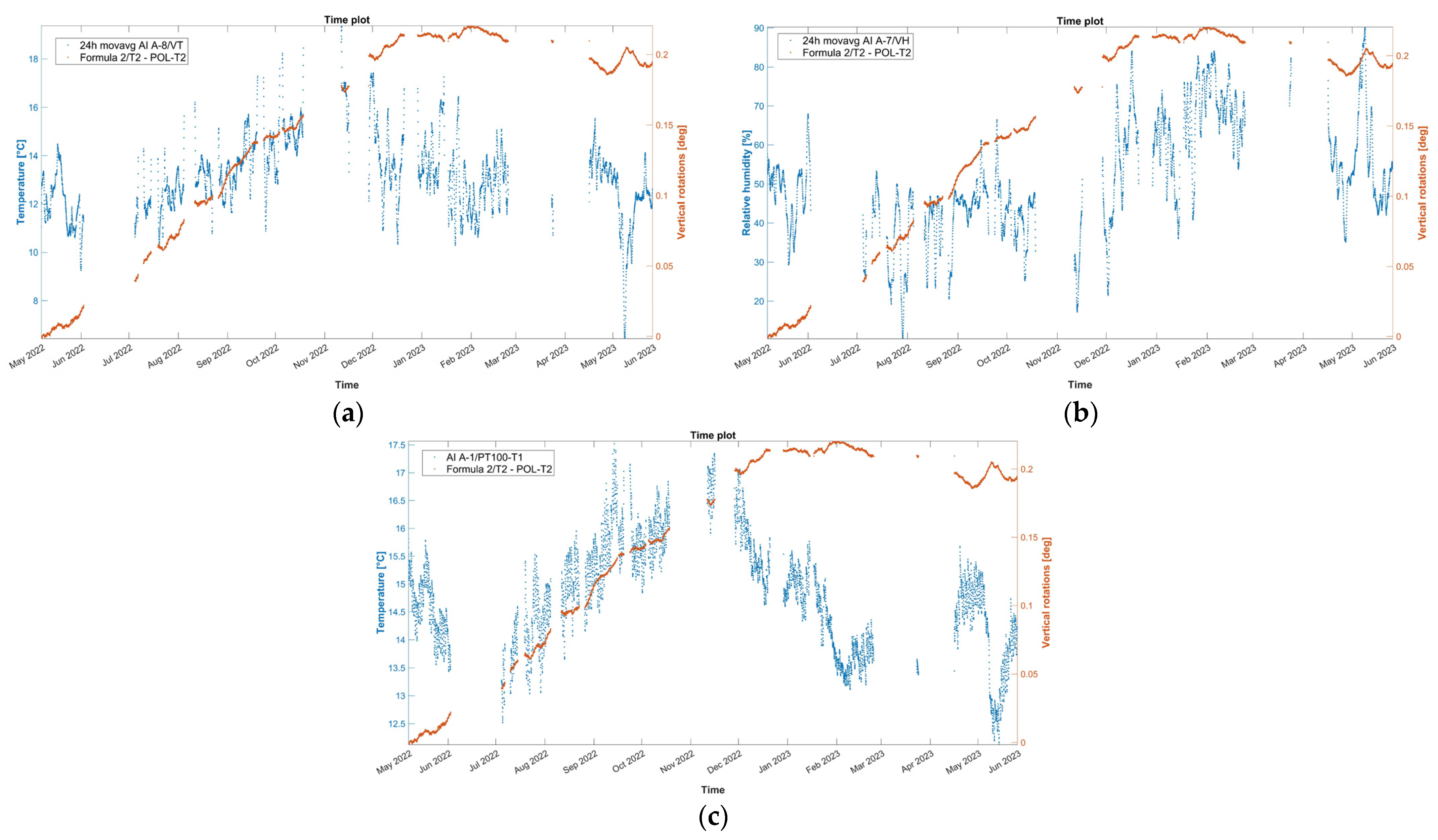
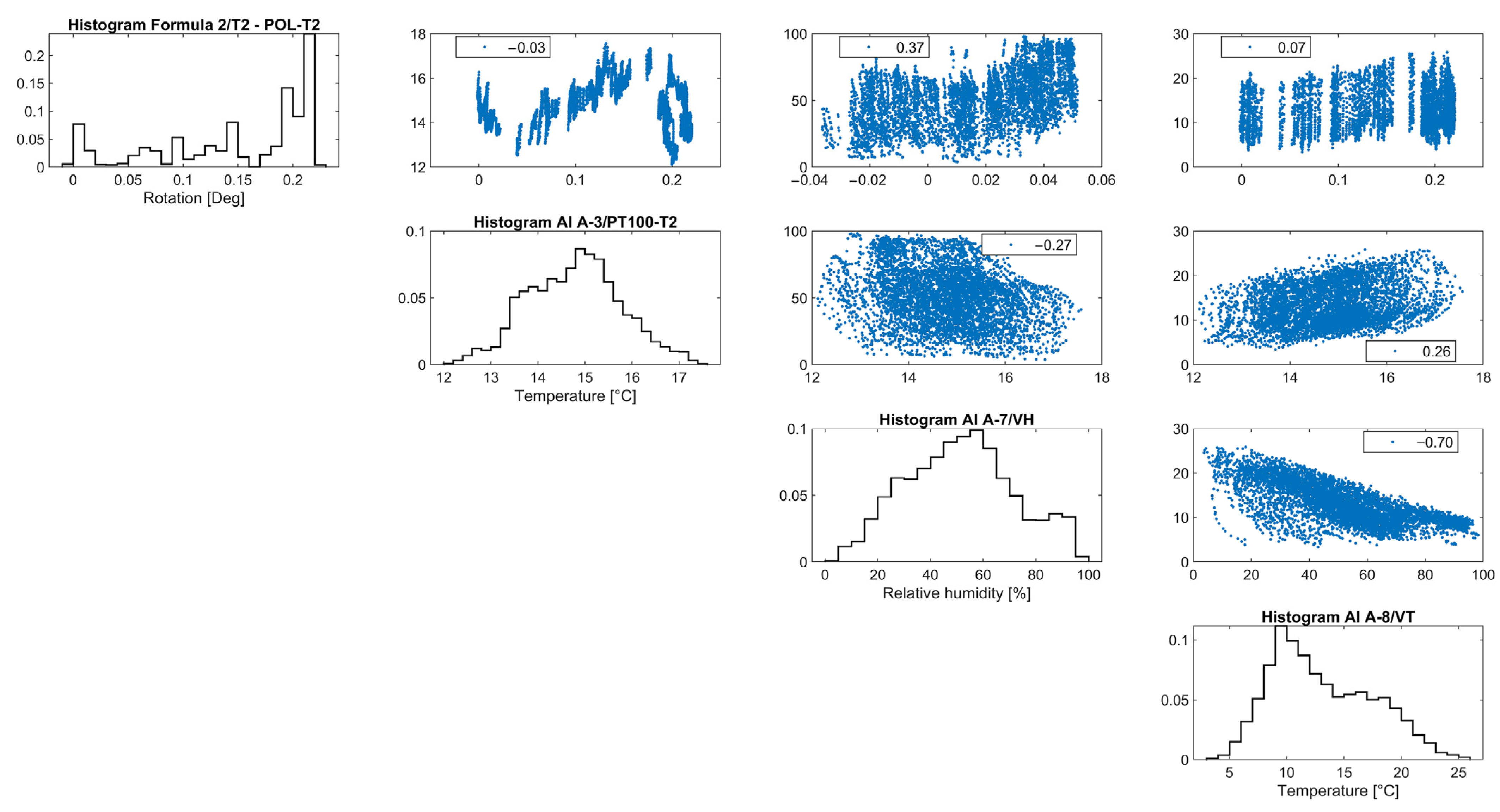
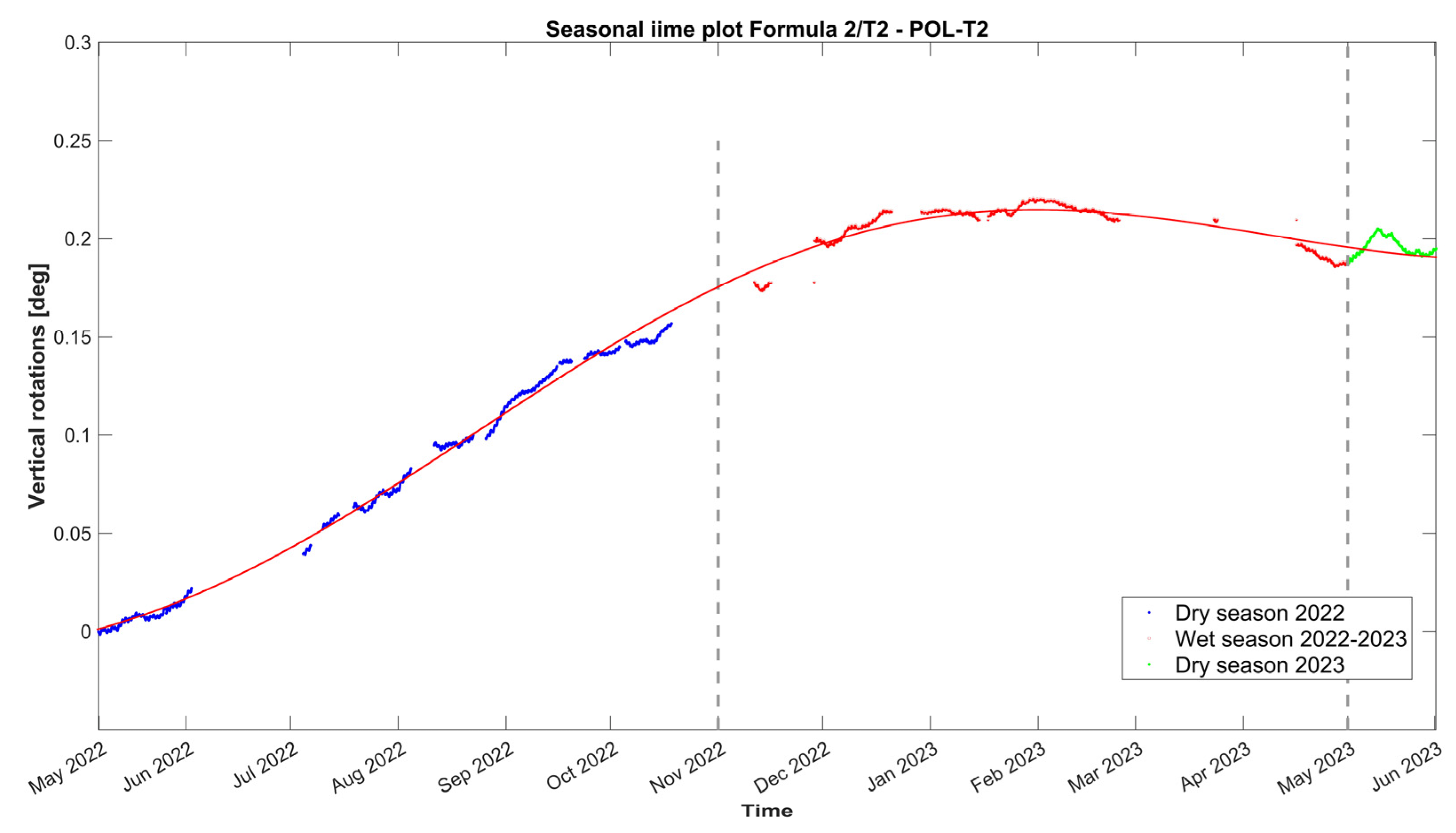
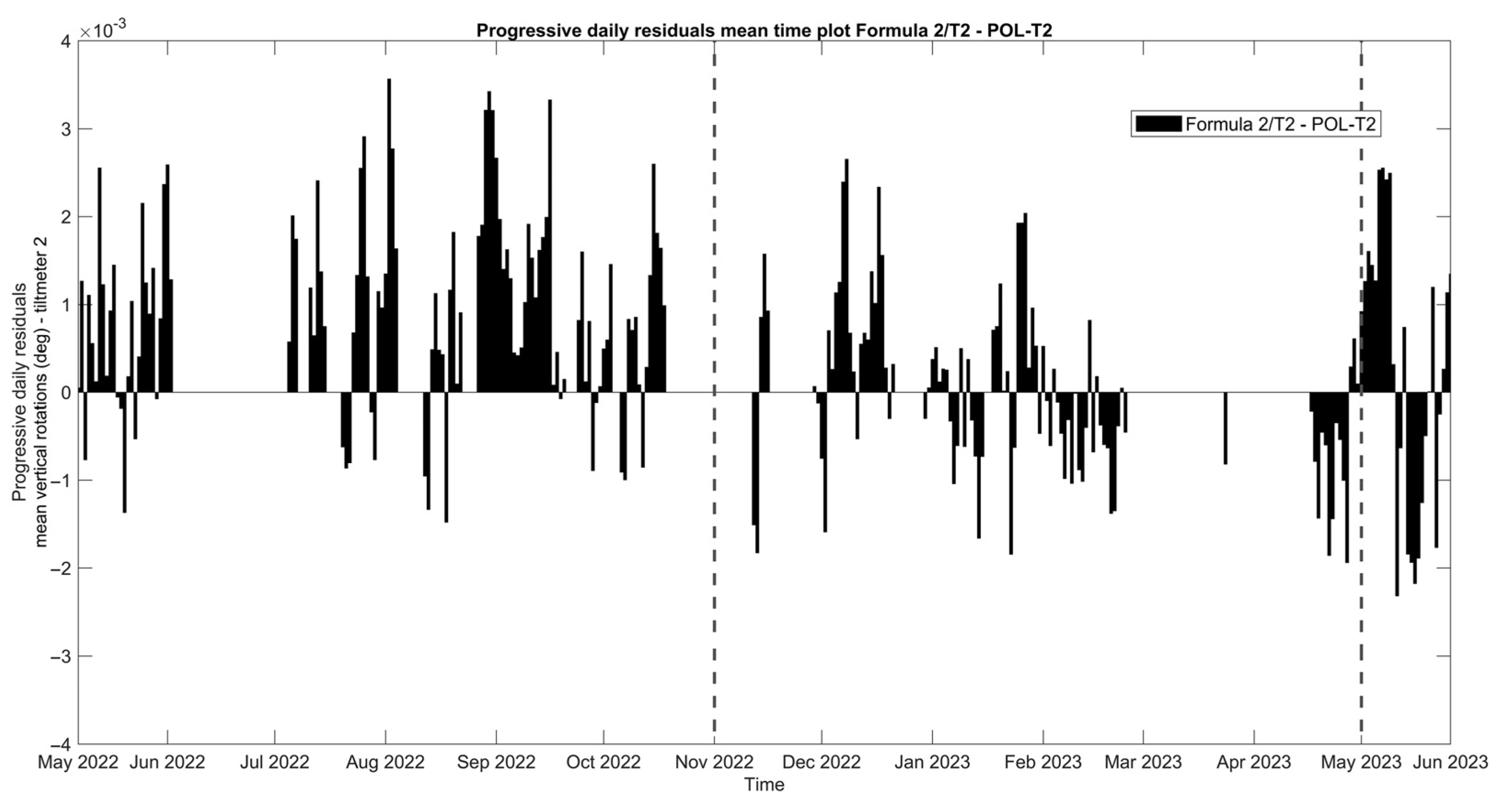


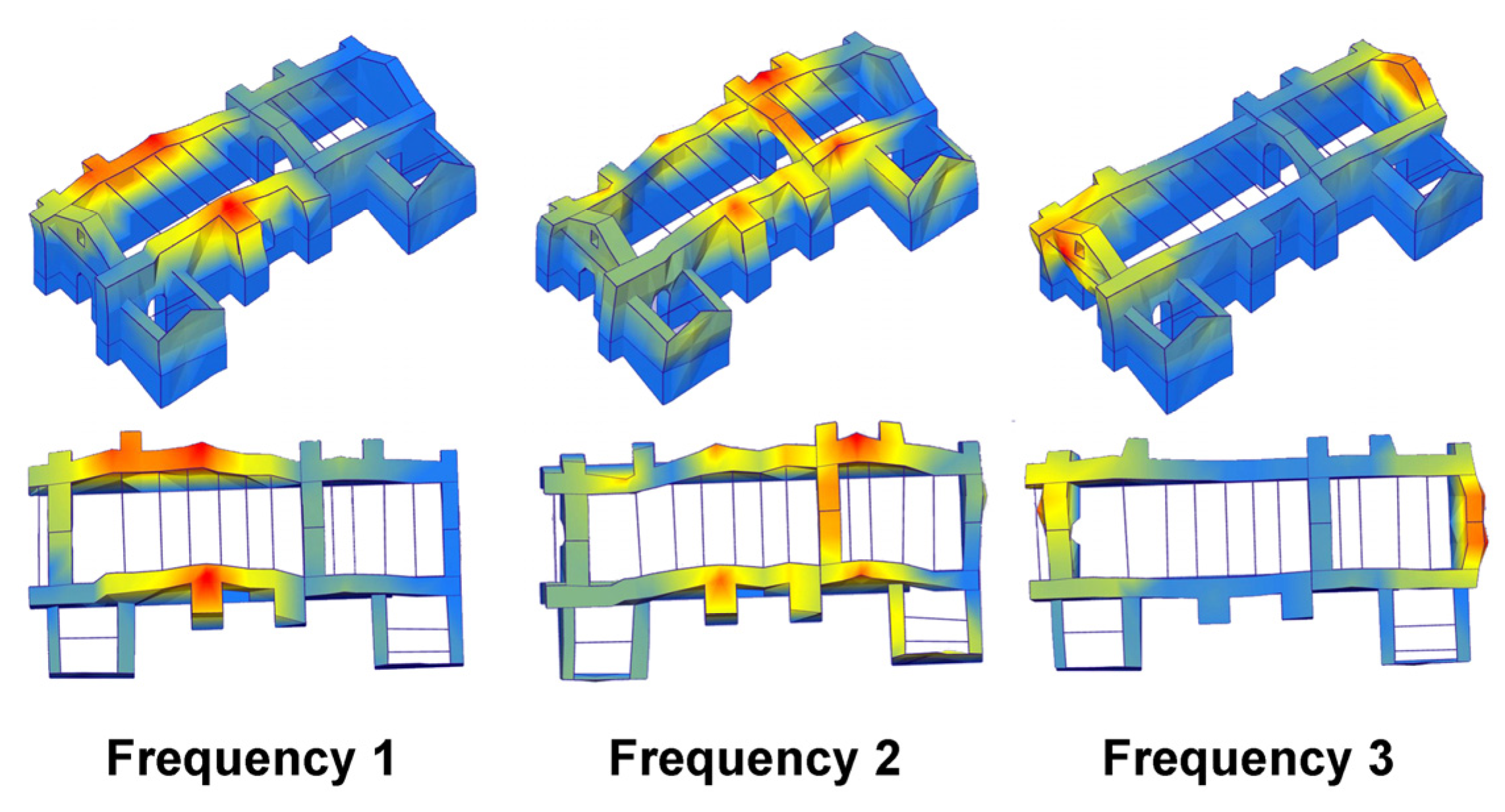

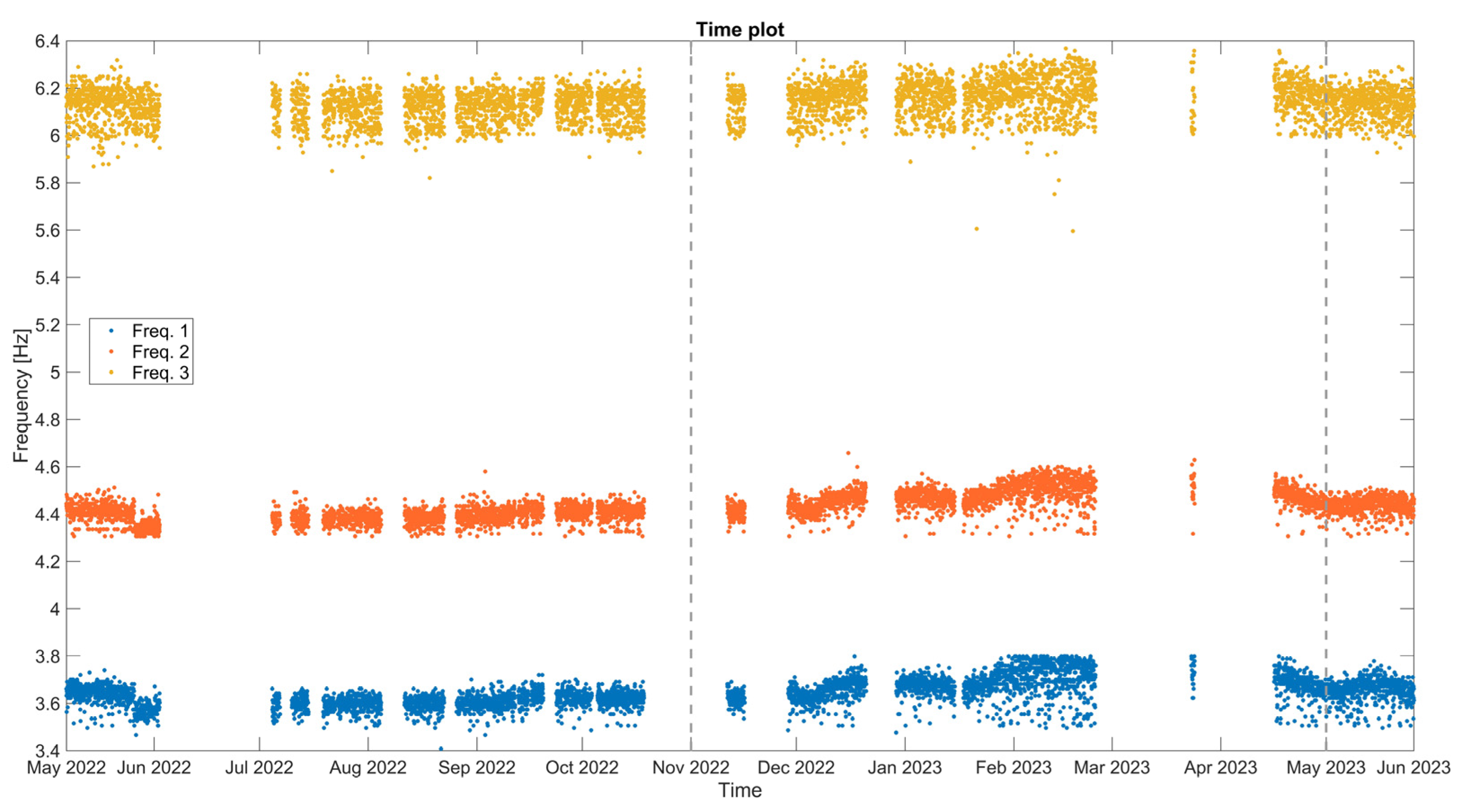

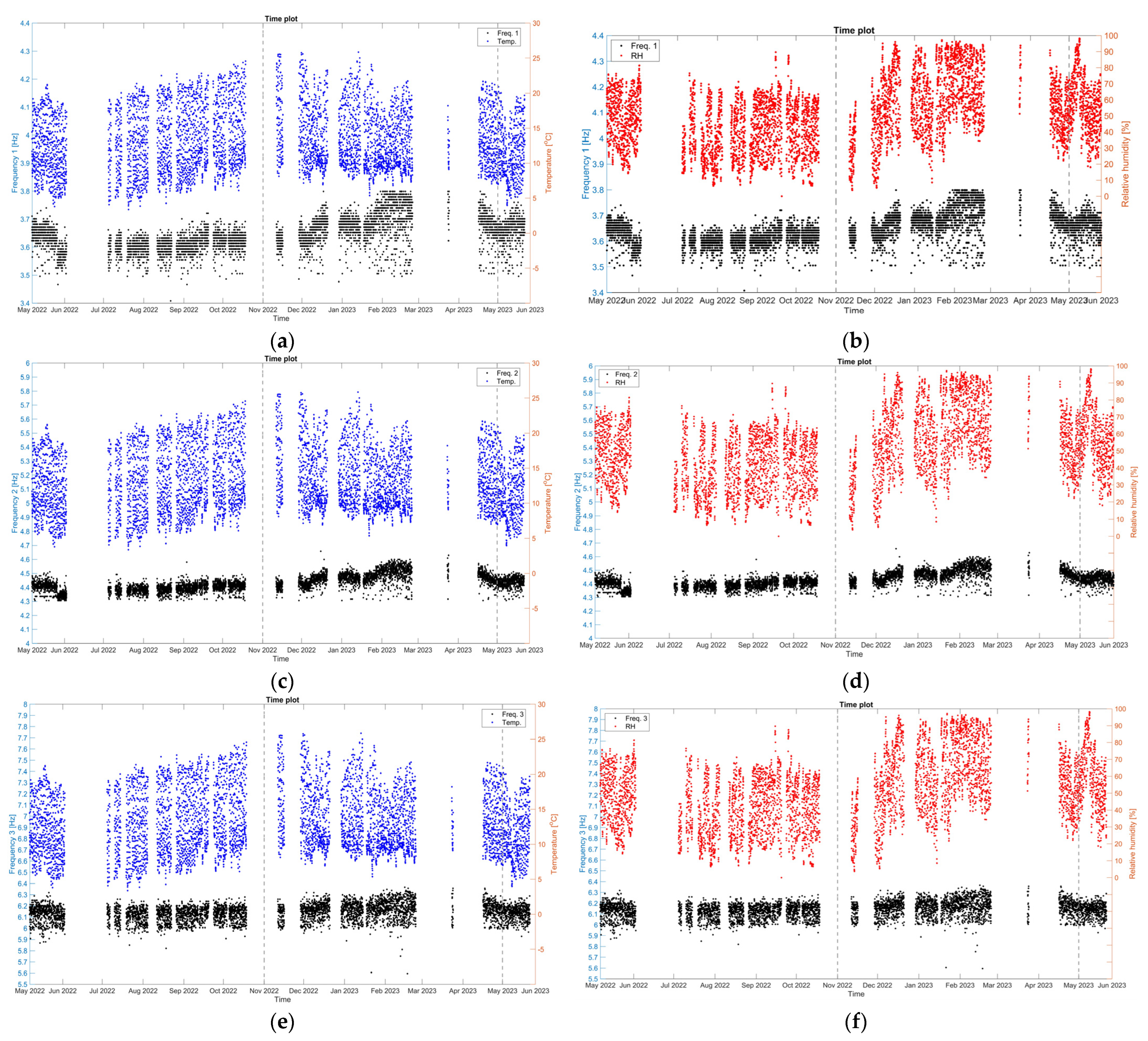
| External | Internal | Internal Walls | |||||||||
|---|---|---|---|---|---|---|---|---|---|---|---|
| Altar Niche | Arch Nave | Sotocoro | |||||||||
| Temp/RH PT100 | Data Logger | PT100 T1 | PT100 CR | PT100 T2 | |||||||
| Air Temperature (°C) | Relative Humidity (%) | Air Temperature (°C) | Relative Humidity (%) | Air Temperature (°C) | Relative Humidity (%) | Air Temperature (°C) | Relative Humidity (%) | Wall Temperature (°C) | |||
| Median | 12.29 | 51.43 | 14.00 | 50.00 | 14.00 | 53.00 | 14.30 | 47.10 | 15.69 | 15.21 | 14.82 |
| Mean | 13.11 | 51.43 | 13.87 | 50.69 | 13.99 | 53.40 | 14.41 | 48.26 | 15.61 | 15.17 | 14.78 |
| Std | 4.41 | 20.48 | 1.32 | 10.82 | 1.07 | 12.42 | 1.21 | 9.85 | 1.20 | 0.86 | 0.98 |
| Min | 3.38 | 3.71 | 10.5 | 19.0 | 10.50 | 15.00 | 11.6 | 21.4 | 12.37 | 12.88 | 12.12 |
| Max | 25.86 | 98.23 | 18.0 | 73.0 | 18.76 | 77.00 | 18.2 | 69.0 | 18.40 | 17.53 | 17.57 |
| 1st Quart. | 9.67 | 36.20 | 13.00 | 43.00 | 13.32 | 43.50 | 13.55 | 41.10 | 14.92 | 14.52 | 14.05 |
| 3rd Quart. | 16.49 | 64.96 | 15.00 | 60.00 | 14.50 | 64.50 | 15.20 | 56.90 | 16.43 | 15.81 | 15.43 |
| External | Internal | Internal Walls | |||||||||
|---|---|---|---|---|---|---|---|---|---|---|---|
| Altar Niche | Arch Nave | Sotocoro | |||||||||
| Temp/RH PT100 | Data Logger | PT100 T1 | PT100 CR | PT100 T2 | |||||||
| Air Temperature (°C) | Relative Humidity (%) | Air Temperature (°C) | Relative Humidity (%) | Air Temperature (°C) | Relative Humidity (%) | Air Temperature (°C) | Relative Humidity (%) | Wall Temperature (°C) | |||
| Median | 12.41 | 43.24 | 13.50 | 45.00 | 14.09 | 41.70 | 14.32 | 42.20 | 16.21 | 15.46 | 15.05 |
| Mean | 13.09 | 42.46 | 13.47 | 43.88 | 14.16 | 40.90 | 14.39 | 41.48 | 16.16 | 15.42 | 15.03 |
| Std | 4.64 | 16.87 | 1.33 | 7.33 | 1.33 | 6.68 | 1.29 | 6.13 | 0.86 | 0.72 | 0.88 |
| Min | 3.38 | 6.47 | 10.5 | 19.0 | 11.0 | 20.7 | 11.6 | 21.4 | 13.56 | 13.14 | 12.52 |
| Max | 24.58 | 89.69 | 17.5 | 64.0 | 18.1 | 59.2 | 18.0 | 59.0 | 18.38 | 17.11 | 17.57 |
| 1st Quart. | 9.40 | 28.25 | 12.50 | 39.50 | 13.20 | 37.40 | 13.40 | 38.40 | 15.58 | 14.91 | 14.37 |
| 3rd Quart. | 16.95 | 56.33 | 14.50 | 49.00 | 15.10 | 45.20 | 15.31 | 45.33 | 16.75 | 15.97 | 15.65 |
| External | Internal | Internal Walls | |||||||||
|---|---|---|---|---|---|---|---|---|---|---|---|
| Altar Niche | Arch Nave | Sotocoro | |||||||||
| Temp/RH PT100 | Data Logger | PT100 T1 | PT100 CR | PT100 T2 | |||||||
| Air Temperature (°C) | Relative Humidity (%) | Air Temperature (°C) | Relative Humidity (%) | Air Temperature (°C) | Relative Humidity (%) | Air Temperature (°C) | Relative Humidity (%) | Wall Temperature (°C) | |||
| Median | 12.47 | 59.47 | 14.50 | 60.00 | 14.37 | 58.00 | 14.50 | 57.20 | 15.35 | 15.13 | 14.81 |
| Mean | 13.54 | 59.69 | 14.51 | 56.98 | 14.53 | 55.15 | 14.66 | 54.65 | 15.28 | 15.14 | 14.79 |
| Std | 4.21 | 20.77 | 1.07 | 10.10 | 1.09 | 9.58 | 1.09 | 8.77 | 1.24 | 0.87 | 0.95 |
| Min | 5.37 | 3.71 | 12.0 | 20.5 | 12.1 | 23.0 | 12.5 | 25.8 | 12.99 | 13.63 | 13.12 |
| Max | 25.86 | 97.15 | 18.0 | 73.0 | 18.8 | 70.7 | 18.2 | 69.0 | 18.40 | 17.53 | 17.34 |
| 1st Quart. | 10.08 | 44.74 | 13.50 | 50.50 | 13.72 | 48.90 | 13.84 | 48.90 | 14.32 | 14.31 | 13.95 |
| 3rd Quart. | 16.62 | 76.53 | 15.00 | 65.00 | 15.19 | 62.70 | 15.28 | 61.70 | 16.01 | 15.78 | 15.32 |
| Freq. 1 [Hz] | Freq. 2 [Hz] | Freq. 3 [Hz] | ||||||||||
|---|---|---|---|---|---|---|---|---|---|---|---|---|
| Total | Season 1 | Season 2 | Season 3 | Total | Season 1 | Season 2 | Season 3 | Total | Season 1 | Season 2 | Season 3 | |
| Median | 3.64 | 3.61 | 3.68 | 3.66 | 4.42 | 4.39 | 4.47 | 4.44 | 6.15 | 6.13 | 6.17 | 6.14 |
| Mean | 3.64 | 3.61 | 3.68 | 3.66 | 4.43 | 4.39 | 4.47 | 4.44 | 6.14 | 6.12 | 6.17 | 6.13 |
| St. dev. | 0.06 | 0.04 | 0.06 | 0.04 | 0.06 | 0.04 | 0.05 | 0.03 | 0.07 | 0.07 | 0.08 | 0.06 |
| COV | 1.6% | 1.1% | 1.6% | 1.1% | 1.4% | 1% | 1.1% | 1.0% | 1.1% | 1.1% | 1.3% | 1.0% |
| Min | 3.41 | 3.41 | 3.48 | 3.50 | 4.31 | 4.31 | 4.31 | 4.31 | 5.60 | 5.82 | 5.60 | 5.93 |
| Max | 3.80 | 3.74 | 3.80 | 3.78 | 4.66 | 4.58 | 4.66 | 4.51 | 6.40 | 6.32 | 6.37 | 6.30 |
| 1st Quart | 3.60 | 3.59 | 3.64 | 3.64 | 4.39 | 4.38 | 4.44 | 4.41 | 6.09 | 6.07 | 6.12 | 6.09 |
| 3rd Quart | 3.68 | 3.63 | 3.71 | 3.68 | 4.46 | 4.41 | 4.50 | 4.46 | 6.19 | 6.17 | 6.22 | 6.18 |
Disclaimer/Publisher’s Note: The statements, opinions and data contained in all publications are solely those of the individual author(s) and contributor(s) and not of MDPI and/or the editor(s). MDPI and/or the editor(s) disclaim responsibility for any injury to people or property resulting from any ideas, methods, instructions or products referred to in the content. |
© 2024 by the authors. Licensee MDPI, Basel, Switzerland. This article is an open access article distributed under the terms and conditions of the Creative Commons Attribution (CC BY) license (https://creativecommons.org/licenses/by/4.0/).
Share and Cite
Karanikoloudis, G.; Barontini, A.; Mendes, N.; Lourenço, P.B. An Integrated Data Acquisition Approach for the Structural Health Monitoring and Real-Time Earthquake Response Assessment of a Retrofitted Adobe Church in Peru. Sensors 2024, 24, 5327. https://doi.org/10.3390/s24165327
Karanikoloudis G, Barontini A, Mendes N, Lourenço PB. An Integrated Data Acquisition Approach for the Structural Health Monitoring and Real-Time Earthquake Response Assessment of a Retrofitted Adobe Church in Peru. Sensors. 2024; 24(16):5327. https://doi.org/10.3390/s24165327
Chicago/Turabian StyleKaranikoloudis, Georgios, Alberto Barontini, Nuno Mendes, and Paulo B. Lourenço. 2024. "An Integrated Data Acquisition Approach for the Structural Health Monitoring and Real-Time Earthquake Response Assessment of a Retrofitted Adobe Church in Peru" Sensors 24, no. 16: 5327. https://doi.org/10.3390/s24165327








